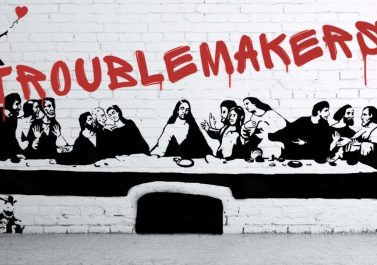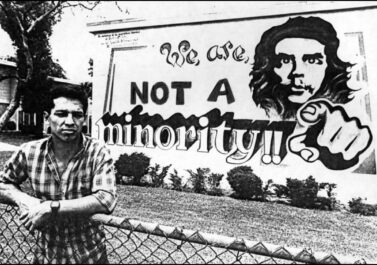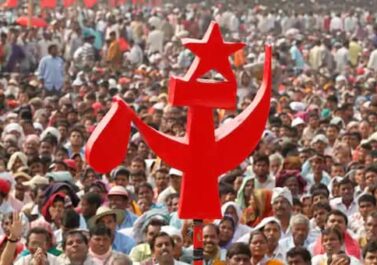
This is a contribution to our debate written by a comrade – feel free to respond.
Why was this written?
This article has been written as a contribution to discussion following the post from August, 2020 where a comrade raised the question “Are we Part of the Left?”. My response comes after reading “Class Power on Zero Hours” (CPoZH) and participating in various discussions amongst fragments of the “revolutionary minority” – a concept that needs some clarification.
Like a number of other comrades I would like to respond positively to the appeal in the final chapters of CPoZH. The Angry Workers of the World (AWW)’s established practice and the content of the book both reflect a grasp of the importance of two key elements confronting those committed to the proletarian revolution.
Firstly, there is a need to maintain and develop an understanding of both the possibility of, and necessity for, a global overturning of the capitalist system. Secondly, the original AWW collective has displayed a commitment to explore and develop living interconnections between themselves as “conscious revolutionaries” and the rest of our class.
That essence was clearly shown in the initiative that was originally called “lets get rooted”. Happily the initiative has survived the challenges of the pandemic, part of the latest phase of the crisis of the bosses’ system, even if the quirkish title has been abandoned.
Inevitably, the process of reaching out to engage new contacts has resulted in a fresh layer of militants coming into contact with each other and with the original AWW collective. As somebody who is part of that continuing process I would like to make some comments. I have tried to do so bearing in mind the underlying arguments in CPoZH and particularly the analysis and appeal in Chapters 12-15. It is clear that the AWW collective are revolutionaries who share with others, a distinct understanding of the past, present and future of class society.
Having left one of the “Left Communist Legacy Organisations” (LefCLOs) during 2020 after some 28 years I remain convinced that there is a necessary and essential political separation between the revolutionary minority and “the left”. Based on discussions in a number of forums in recent months it is also obvious that there is much room for further clarification around the question about whether and how that differentiates “us” from those with the label “Left”.
To avoid misunderstandings it should be clearly stated that recognising the unique quality of revolutionary awareness does not imply an agreement with the developed “praxis” of the LefCLOs. Indeed, there are elements of their “way of working” which will be referred to later which serve as a warning for any group of comrades who are attempting to develop revolutionary “organisation” here and now. In particular, the need to avoid “sect building” will be returned to later when discussing the need to grow the revolutionary minority without drifting into that dead end.
The revolutionary minority (tRM) and the Left
The original draft of this document and this final, with all its faults!, version have been refined as a result of recent discussions in at least four arenas :-
- Fellow revolutionaries who have also been attracted to the AWW’s project both before and after the appearance of CPoZH
- Other revolutionaries in Britain who have previously been affiliated to one or other LefCLO
- Meetings convened by revolutionary organisations including AWW, ACG and ICC and other organisations such as XR, whose leadership is, in my view, firmly outside the Revolutionary Minority
- A number of Social Media forums that bring together a wide variety of individuals and tendencies committed to, or wishing to examine revolutionary “praxis”
- Conversations with people in my area about issues at work (particularly during the pandemic) and other long-rooted systemic problems, particularly the multi-generational problem of the failure of capitalism to generate sufficient housing for local working-class people
In many such discussions references were made to current or recent struggles. The “communications revolution” has made it far easier for us to have some knowledge of struggles in workplaces across the globe. The same applies to other social struggles against, for example, housing shortages/evictions, results of the capitalist crisis such as lack of food or adequate health care for the working class, the growth in repression headed both by the state machines and the arms-length gangsterism. There is also the resistance to manifestations of the “special oppressions” that are part of the bosses’ system.
Even, or perhaps particularly, during the pandemic struggles (in no particular order) such as “Black Lives Matter”, defence of women’s rights, issues around migrant workers, and the struggles around the treatment of gay/trans people have all been apparent.
The ruling class has been forced to admit that the Covid 19 pandemic and earlier epidemics have flowed from the drives of capitalism in forcing features of their destructive system into areas of the planet where a far healthier balance between humanity and nature has previously existed. Of course that admission has gone alongside massive ongoing deforestation particularly in Brazil with resistance, of course, also appearing.
In no way should such protests/movements in the paragraphs above be sneered at or simply dismissed as hopeless expressions of misdirected frustration. But, and here is one of the most important points, revolutionaries have a responsibility to relate to such protests in a way which is markedly different from the “left wing of capitalism” i.e. those who seek more crumbs from the table while the bosses own the bakeries. Perhaps needless to add, that analogy also applies to the core nature of struggles for higher wages, struggles which currently appear to remain at a low level in Britain
Unlike the interventions by the agents of what CPoZH Chapter 12 describes as “Democratic Socialism”, In all these movements [“against the existing social and political order”] they [communists] bring to the front , as the leading question in each, the property question, no matter what its degree of development at the time. The Communist Manifesto.
What do the Revolutionary Minority share?
The working class – the world-wide class of women and men of no property – is not static. It is forever changing shape in a complex interaction with the development of the capitalist social system.
Its complexity and permanent state of flux means that it is inevitable that the level of “class consciousness”/revolutionary awareness will vary within the class in different times and in different places. Awareness that “a better world is possible” partly expressed itself amongst part of our class for a few short months in Paris 150 years ago. A much bigger layer had sufficient understanding of the possibility and need to create a different future in the struggles that ended the First World War and saw capitalism challenged during the “revolutionary wave” from 1917 onwards.
The precise formulations reflecting the revolutionary hope for humanity could not be identical in 1848, 1871, 1919 and 1936. Nevertheless, it is not difficult to pick out a short list of the key features which are shared by the many generations committed to proletarian revolution.
Central elements of the awareness that is shared by the Revolutionary Minority include :-
- “ ….that the emancipation of the working classes must be conquered by the working classes themselves.” Rules of the First International.
That bit of ABC for revolutionaries is at the core of the need to differentiate ourselves from the approach of “Democratic Socialism”. It is also needs to be the starting point for how we relate to those organisations such as Trades Unions that exist within and reinforce the existing power structures and class relationships.
- Our aim is “full communism” – a world without states, borders, money, waged labour or any other remnants of the muck of class society. The vision for a sustainable future driven by the needs of humanity in harmony with the nature – “… an association of free people, working with the means of production held in common” Capital, Volume 1.
- All previous history suggests that no ruling class willingly surrenders ownership or control. The idea that capitalism will organically transform into its negation is a dangerous but common fantasy.
A further shared understanding which history has taught us is that :-
- Revolutionaries do not see themselves as “government in waiting”. It will be significant layers of an increasingly aware working-class via their own self-organisation who will carry out the revolutionary rupture and implement the commencement of the transition towards full communism.
Revolutionary Awareness and Organisation
Fundamentally, comrades gravitate towards AWW, or other revolutionary formations, because we share an analysis that there is both the need for and the possibility of an end to class society via the self-liberation of the working class. It is unavoidably true that sharing that awareness marks out the revolutionary minority from the rest of humanity including the rest of the working class.
Our desire to actualise that vision pushes us to relate to organisations and projects where we cooperate to interact amongst ourselves and, essentially, engage with others who do not share our core understanding.
As part of our chosen “mission” we need to explain that our advocacy for global proletarian revolution is not identical with opposing capitalism’s right wing, or defending the “democratic socialist” (as used in CPoZH) organisations or structures. In fact, we accept a responsibility to put forward the challenging analysis that “democratic socialism” and its various facets are part of the mechanism which entraps our class in the capitalist framework. That is very different from trying to see ourselves as “the left of the left”.
However, history has shown us many examples of revolutionary fragments never getting beyond, or falling back to, the status of irrelevant, inward-looking sects. How we avoid that is a very big question which will need to unfold over time. Recognising the danger is a useful prerequisite.
Organisation or sect?
The emergence of the proletariat as a class capable of achieving the revolutionary reconstitution of society had taken place in limited areas of Europe by 1848 when Marx and Engels wrote “The Communist Manifesto”.
The massive historic developments that have taken place since then are not within the scope of this article. Certainly, the section headed, “Revolutionary Strategy” in CPoZH helps to explain the nature of the current epoch although it would be foolish to imagine that it must be treated as “the final word”.
During that period of capital increasing its power to dominate society in every part of the globe many generations of militants have been the most aware of the potential and necessity for proletarian revolution. The continuing existence of that “revolutionary minority” has not been a smooth path. Its development has always been subject to changes flowing from historical development, the relationships between classes and the state of the struggles between them.
AWW’s appeal to others in the revolutionary minority is one moment in that ever evolving history. Positive responses have come from forces in various parts of the world including, as is the case of the author of this piece, from Britain where AWW have operated.
Later in this article we will return to thoughts about questions that need to be addressed regarding the vital issue of internationally linking the revolutionary minority.
Firstly, it will hopefully be useful to address some issues around the process of regroupment in Britain that has been sparked by AWW’s activities. During recent correspondence, a comrade summarised a key task very succinctly – “how can we, collectively, agree what is the current situation of class forces in the UK and abroad (with being honest about contradictions inside our class), given that we come from various political traditions“.
Where was the Revolutionary Minority heading?
Hopefully, it is clear that the starting point for this article has been the recognition that the “Revolutionary Minority” (tRM), is distinct from the rest of the working class. The essence of that distinction is that the former consists of those who have the most clear understanding of class society, capitalism and why and how both need to be “consigned to the dustbin of history”.
It is the struggle between classes which allows tRM to emerge and evolve. How segments develop and decay would be a major historical study. The “whys” and “hows” of involvement by particular militants are even more complex questions.
Of course, it is also obvious that the composition of tRM is not fixed. Its size ebbs and flows and, perhaps more critically, so does its “traction” within the class. At any given point in time and varying across geography, differing segments of the class will variously have an awareness of, be groping towards or moving away from, take any notice of or accept any degree of advice or inspiration from tRM.
Although much more could be said about the issue, broad brush it seems undeniable that for the last 40-50 years the position of tRM in relation to the rest of the class has markedly weakened, During the last decades of the last century and perhaps the first of the current one the trajectory was towards revolutionaries shrinking back towards a constellation of mutually hostile sects with its effective periphery also decreasing.
That process was exemplified in the life of the LefCLOs (including the various Bordigist ICP’s, the International Communist Current (ICC) and the Internationalist Communist Tendency(ICT) ). During the period roughly 1980-2015, a key feature in the ossification of these organisations was the claim to hold unique theoretical clarity. In fact such claims were of little value as the “articles of faith” made no impact beyond the organisations’ adherents and immediate periphery.
The LefclOs’ survival has been possible for a number of reasons –
- The dynamics of small group loyalty including beliefs bordering on infallibility and the sense of “we against all others” ;
- The establishment of a routine for “products” in equilibrium with the “human resource” and available finance. When the “inputs” declined, the schedule of “products” e.g. printed material and interventions was adjusted downwards and vice versa ;
- The cadre of the organisations have largely been located in Western Europe and/or North America. By and large they have been able to carry out their activities free from significant state repression;
- An ingrained culture of theoretical homogeneity even on minor points of analysis. The maintenance of that culture has a dialectical relationship both with the extremely low levels of recruitment and the lack of engagement (beyond self-justified rejection) with ideas from outside.
There is no reason to believe that any current organisation, including any of the LefCLOs, has the potential to simply expand into the next revolutionary proletarian party.
To paraphrase – The LefCLOs have interpreted the world in various ways. The point however is to change it.
More recently … and more positively
CPoZH is centred around the experience of the AWW collective starting in 2014. The narrative coincides with other developments that point towards a meaningful reconstitution of tRM.
During that period, and very probably starting a little earlier the landscape around tRM has shifted significantly.
The critical background to this has been the changes around the way in which capitalism works and the related changes to the composition of the working class. For those who strive to maintain an analysis that reflects a proletarian revolutionary understanding the changes flow from the workings of a global capitalist system suffering phase after phase of crisis, the last phase starting with the crash of 2008. Without restating all the conclusions of CPoZH and related works, the changes during this phase include :-
- Ongoing shifting of production including consumer goods such as electronics and clothing to South and East Asia
- The creation of new capitalist concentrations (including new proletarian centres) notably in China
- Erosion of traditional patterns of employment in the “metropolitan areas”
- Increasing prevalence of insecure patterns of employment and “gig” working
- Increasing examples of workers being paid less than the amount required to reproduce ourselves – sometimes compensated by state subsidies
- Massive increases in the use of Information and Communications Technology including app controlled gig working, robotics in production and fragile “Just in Time” supply chains
Interlaced with those changes around the sphere directly relating to waged labour there have also been others flowing from the deepening crisis :-
- The collapse of significant areas (including Yemen, Iraq, Syria and Ukraine) into arenas for “wars without end”
- Forced migration due to a variety of causes including: State repressive action (e.g. Rohingya), ecological degradation to the point of starvation (Sahel and sub-Saharan African), unemployment and/or gangsterism (Central America)
- Destruction of ecology on which indigenous peoples depend (e.g. Brazil)
- Increasing state repression (including China, Philippines, Venezuela, Turkey, Russia, Syria)
- Last, but clearly not least, the appearance of epidemics and pandemics flowing from worldwide capitalism’s incurably rapacious drive for profit.
In parallel to these changes in the composition of the working class new formations and ways of working have appeared in and around tRM.
The increasing use of the Internet and Social Media has allowed the mushrooming of groups and journals with a commitment to or a wish to explore revolutionary traditions and “praxis”.
The shape of tRM in Britain has also changed during the last 10 or more years. Political formations such as “The Commune” and “Plan C” have attempted to grapple with a revolutionary praxis before disintegrating and/or adapting to the Corbynite variant of left labourism.
There have also been flare-ups of Direct Action for example spinning off from the “Black Lives Matter” upsurge. Without commenting on the motivation or perspective of the leadership of Extinction Rebellion (XR), it is also clear that large numbers of previously “politically” inactive individuals, including many working class people, discovered a path towards activism via XR.
In addition to such developments, the new generation of British-based tRM has been active in the many relevant forums and E publications that have mushroomed across social media.
For this emerging generation, the key challenge which AWW’s approach begins to address is how tRM can connect positively with the “life of the working class” as the class is confronted with the many-faced attacks of the crisis-ridden bosses’ system.
Appropriate and mistaken conclusions
At this stage the new periphery around AWW is “a mixed bag”. Comrades have been attracted to the project from differing political traditions and understanding. That is a valuable process but it also presents challenges. Synthesising a new “praxis” needs to be progressed gradually and patiently.
Arguing for and from a revolutionary understanding has to be central to the ethos of AWW as it moves forward.
That approach does not imply starting with the intention of “rejecting” or repelling interested militants. However, we do need tograsp, through comradely discussion, issues such as the role of Trade Unions and the wisdom or otherwise of self-styled revolutionaries also being representatives of and/or spokespeople for them.
Although occasional references have been made to “revolutionary organisation” it would be entirely unhelpful to try to drive forward the AWW “project” towards a tightly-defined blueprint.
At this stage it seems more useful to recognise that the shape and form of revolutionary organisations is not historically invariable or pre-determined.
Continuing the use of open forums on the “national” (a ruling class concept but a clumsy shorthand) level as well as around smaller localities and globally seems an obvious method for groping towards a future organisation.
In summary it seems certain that those from the Revolutionary Minority who are attracted by AWW/CPoZH will recognise that a key purpose of the process of revolutionaries assembling is to interact with the rest of the class to increase the possibilities of a communist future. Neglecting, or consistently failing in, the challenge of effective interaction is a path to organisational decay and irrelevance but simultaneously we must never stop developing and spreading a revolutionary perspective.
If you have read this far then please consider the author’s, only partially ironic, recipe for an organisational vision –
Forward to the First International with Internet!
KIT
March 2021



